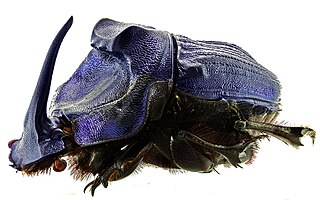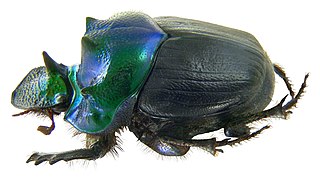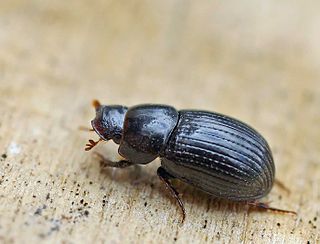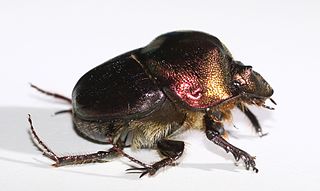
The scarab beetle subfamily Scarabaeinae consists of species collectively called true dung beetles. Most of the beetles of this subfamily feed exclusively on dung. However, some may feed on decomposing matter including carrion, decaying fruits and fungi. Dung beetles can be placed into three structural guilds based on their method of dung processing namely rollers (telecoprids), dwellers (endocoprids) and tunnelers (paracoprids). Dung removal and burial by dung beetles result in ecological benefits such as soil aeration and fertilization; improved nutrient cycling and uptake by plants, increase in Pasture quality, biological control of pest flies and intestinal parasites and secondary seed dispersal. Well-known members include the genera Scarabaeus and Sisyphus, and Phanaeus vindex.
Amphionthophagus is a subgenus of scarab beetles in the genus Onthophagus of the family Scarabaeidae. There are at least three described species in Amphionthophagus. They are found in the Palearctic.
Colobonthophagus is a subgenus of scarab beetles in the genus Onthophagus of the family Scarabaeidae. There are more than 30 described species in Colobonthophagus. They are found in the Palaearctic and Indomalaya.

Coprophanaeus is a genus in the family Scarabaeidae. The genus is almost entirely Neotropical, with a single species, C. pluto, ranging into southernmost Texas in the United States. They are medium-sized to large beetles, with the South American C. ensifer and C. lancifer sometimes exceeding 5 cm (2 in) in length, making these two some of the largest dung beetles in the world and the largest in the Americas. They often have a horn on the head, and are typically a bright metallic color, most often blue or green, or black. These diurnal or crepuscular beetles are excellent diggers and good fliers.

Diastellopalpus is a genus of Scarabaeidae or scarab beetles in the superfamily Scarabaeoidea. It was considered a subgenus of Onthophagus by some authorities.
Euonthophagus is a genus of Scarabaeidae or scarab beetles in the superfamily Scarabaeoidea. It was considered a subgenus of Onthophagus by some authorities.
Altonthophagus is a subgenus of scarab beetles in the genus Onthophagus of the family Scarabaeidae. There are about 12 described species in Altonthophagus. They are found in the Palearctic and Indomalaya.

Eurysternus is a genus of Scarabaeinae or dung beetles in the family Scarabaeidae. It is normally placed in the Oniticellini, although some authors consider it the single genus in the tribe Eurysternini (e.g.). It is restricted to the Neotropics and includes 53 recognized species.

Furconthophagus is a subgenus of scarab beetles in the genus Onthophagus of the family Scarabaeidae. There are more than 20 described species in Furconthophagus. They are found mainly in Africa, Asia, and Europe.
Gibbonthophagus is a subgenus of scarab beetles in the genus Onthophagus of the family Scarabaeidae. There are more than 40 described species in Gibbonthophagus. They are found mainly in Asia.
Ontherus is a genus of Scarabaeidae or scarab beetles in the superfamily Scarabaeoidea.

Onthophagus is a genus of dung beetles in the Onthophagini tribe of the wider scarab beetle family, Scarabaeidae. It is the most species-rich and widespread genus in the subfamily Scarabaeinae, with a global distribution.
Onthophagiellus is a subgenus of scarab beetles in the genus Onthophagus of the family Scarabaeidae. There are more than 20 described species in Onthophagiellus. They are found primarily in Asia and Africa.

Digitonthophagus gazella is a species of scarab beetle. It belongs to the genus Digitonthophagus, which was promoted from subgenus to genus level in 1959. There has been some confusion regarding the application of the names with many people using the outdated name Onthophagus gazella. Dung beetle experts use the term Digitonthophagus gazella.

Proagoderus is a genus of Scarabaeidae or scarab beetles in the subfamily Scarabaeinae. It was considered a subgenus of Onthophagus by some authorities. It includes over 100 species native to Africa and Asia.

Liatongus is a genus of dung beetles in the subfamily Scarabaeinae of the scarab beetle family. At least part of the upper surfaces are without hairs; the head and pronotal disc are generally sculptured; and the genae are rounded, with little or no indentation between the clypeus and the genae. Length ranges from 7.4 to 10.9 mm. Colours vary: they may be uniform brown or dull purple, or have red, white or yellow patterns on the elytra.

Ateuchini is a tribe of dung beetles in the family Scarabaeidae. There are at least 30 genera and 370 described species in Ateuchini.
Malagoniella is a genus of in the beetle family Scarabaeidae. There are about 10 described species in Malagoniella.

Digitonthophagus bonasus, is a species of dung beetle found in India, Sri Lanka, Pakistan, Nepal, Myanmar, Thailand, Afghanistan, Vietnam and Cambodia.











